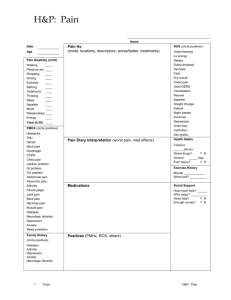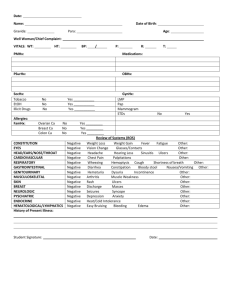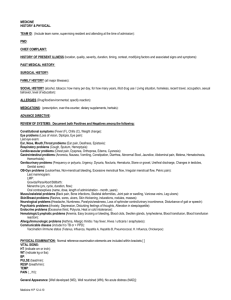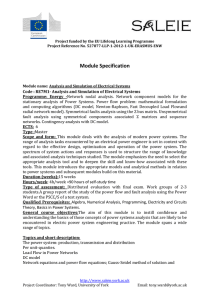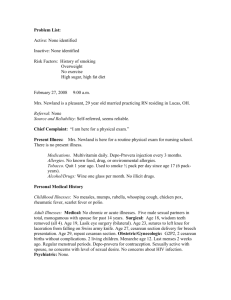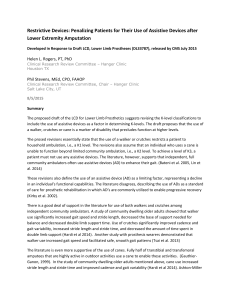DOC
advertisement
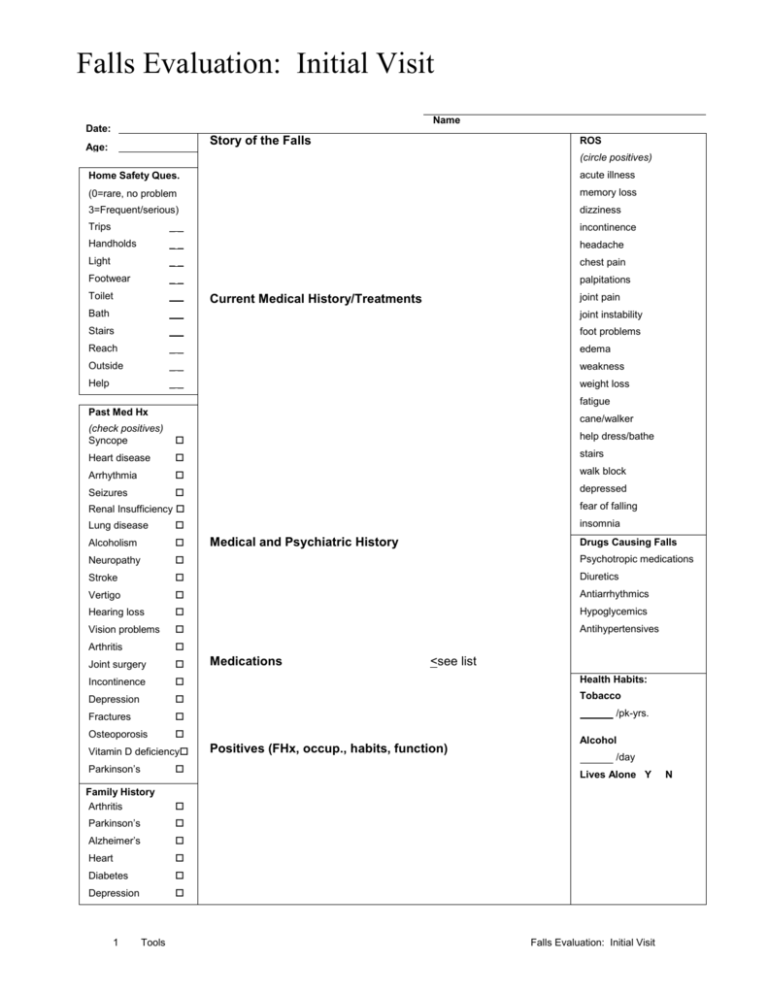
Falls Evaluation: Initial Visit Name Date: Story of the Falls Age: ROS (circle positives) Home Safety Ques. acute illness (0=rare, no problem memory loss 3=Frequent/serious) dizziness Trips __ incontinence Handholds __ headache Light __ chest pain Footwear __ palpitations Toilet __ Bath __ joint instability Stairs __ foot problems Reach __ edema Outside __ weakness Help __ weight loss joint pain Current Medical History/Treatments fatigue Past Med Hx cane/walker (check positives) Syncope help dress/bathe Heart disease stairs Arrhythmia walk block Seizures depressed fear of falling Renal Insufficiency insomnia Lung disease Alcoholism Neuropathy Psychotropic medications Stroke Diuretics Vertigo Antiarrhythmics Hearing loss Hypoglycemics Vision problems Antihypertensives Arthritis Joint surgery Incontinence Health Habits: Depression Tobacco Fractures Osteoporosis Vitamin D deficiency Parkinson’s Family History Arthritis Parkinson’s Alzheimer’s Heart Diabetes Depression 1 Tools Medical and Psychiatric History Medications Drugs Causing Falls <see list /pk-yrs. Positives (FHx, occup., habits, function) Alcohol /day Lives Alone Y Falls Evaluation: Initial Visit N Vital Signs BP sit BP standing P T Wt. lb Ht. Eyes nl conjunctiva & lids Feet no deformity, lesions, tenderness Pupils pupils symmetrical, reactive Nails no clubbing, cyanosis Fundus nl discs & pos elements Footwear supportive, safe, well-fitting Vision acuity and gross fields intact ENT-External no scars, lesions, masses Otoscopic nl canals & tympanic membranes Hearing nl to _ Intranasal nl mucosa, septum, turbinate Ant. Oral nl lips, teeth, gums Oropharynx nl tongue, palate, pharynx ________ Neck palp. symmetrical without masses Thyroid no enlargement or tenderness Resp. effort nl without retractions Chest percuss. no dullness or hyperresonance Chest palp. no fremitus Auscultation nl bilateral breath sounds w/o rales in Neurologic Check nl, circ abn ROM Strength Tones Upper extrem Lower extrem Mental status nl alertness, attentive Cranial nerves w/o gross deficit Coordination nl rapid alternating movement DTRs symmetrical, __ (scale: 0-4+) Sensation nl touch, proprioception Orientation nl to m/d/day/yr, time Tandem walk able, steady One leg balance 30 sec eyes open Psychiatric Mood nl good eye contact, appropriate Memory nl short term and long term memory Thought process nl no delusions, phobias, hallucinations Heart palp. nl location, size Get up and Go Test (circle abnormal, check normal) Cardiac ausc. no murmur, gallop, or rub Sitting balance Carotids nl intensity w/o bruit Arise w/arms folded able Pedal pulses nl posterior tibial & dorsalis pedis Standing balance steady in narrow stance Eyes closed remains steady no masses or tenderness Nudge recovers w/o difficulty L/S no liver/spleen Gait initiation no hesitancy Hernia no hernia identified Step length/ht each foot passes stance, clears floor well Anus/rectal no abnormality or masses Step symmetry step lengths equal, regular Breasts nl inspection & palpation Pattern continuous, regular steps Path straight w/o walking aide Stance steps with heels together Sitting safe, smooth, judges distance correctly Speed 10 feet in less than 10 seconds Abdomen Comments: steady, safe when upright Gait Description Cartoid sinus stimulation (if indicated) Recumbent PreBP____P____PostBP____P____ 2 Tools Falls Evaluation: Initial Visit Assessment Recommendations Environmental changes: Assistive device Exercise program Referrals Straight cane Physical therapist Quad cane Podiatry Hemi-walker Ophthalmology Standard Walker Bone density Rolling walker Emergency response Three-wheel walker VNA home safety evaluation Other: Educational Materials Falls: General Information Medical Evaluation of Falls Choosing and Using a Cane Choosing and Using a Walker What Is a Physical Therapist? Improve Your Balance in 10 Minutes a Day What is an Occupational Therapist? Choosing and Starting an Exercise Program Tai Chi Can You Get Help? After the Fall: A Guide for Patients and Families Steady As You Go: Low Blood Pressure Decrease Your Risk of Falling Avoiding Falls: Tips for Patients with Low Vision Put Your Best Foot Forward: Shoes and Falling Osteoporosis: The Brittle Truth Canes and Walkers 3 Tools Falls Evaluation: Initial Visit
